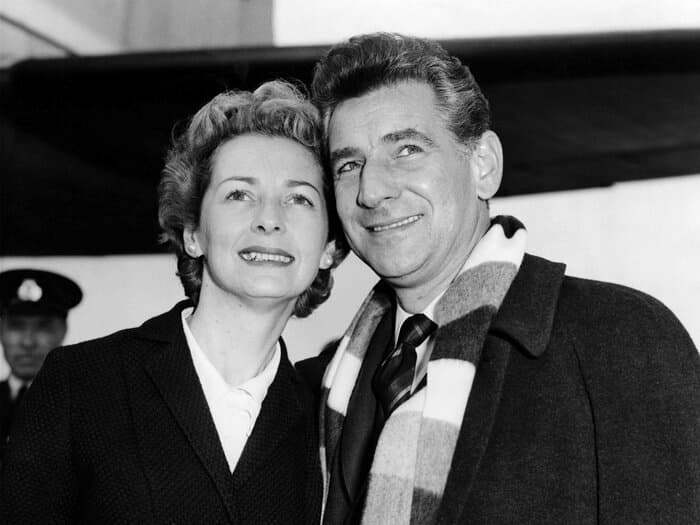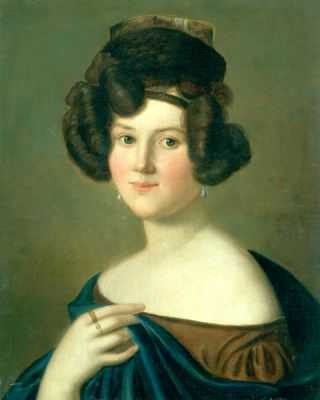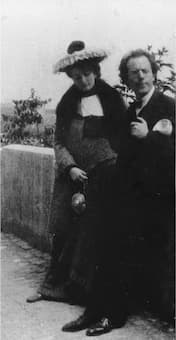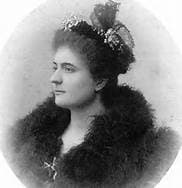Composers can be difficult people to get along with. They can be demanding, perfectionistic, needy, dramatic, and stressed. Their attention can often be split between their creative lives and their personal lives. They are not always the best spouses.
Today we’re kicking off a two-part series, “Ten of the Rockiest Marriages in Classical Music History.”
Here are our first five picks, in reverse order:
10. Leonard Bernstein and Felicia Montealegre
Bernstein: Divertimento ∙ hr-Sinfonieorchester ∙ Andrés Orozco-Estrada
We’re starting off with a couple that has been in the discourse a lot recently after being the subject of Bradley Cooper’s new film Maestro.
Composer and conductor Leonard Bernstein was attracted to men, but being anything other than fully heterosexual in the 1950s would have spelt the end of his career. He also longed to have a stable home life and children, which, at the time, he could not have with a male partner.
Person to Person, hosted by Edward Murrow – Leonard & Felicia Montealegre Bernstein (1955)
He married the Costa-Rican-American actress Felicia Montealegre in 1951. Montealegre was aware of his attraction to men, writing to him around the time their marriage began, “I’ve done a lot of thinking and have decided that it’s not such a mess after all. You are a homosexual and may never change—you don’t admit to the possibility of a double life, but if your peace of mind, your health, and your whole nervous system depend on a certain sexual pattern, what can you do?”

Bernstein and his wife Felicia Montealegre, 1959
Bernstein continued his relationships with men, and not surprisingly, the Bernstein marriage was bumpy. The two ended up splitting up for a period in the 1970s, then reconciled. But it was not an easy marriage, and Felicia especially had to sacrifice a great deal so that it could work.
9. Gabriel Fauré and Marie Frémiet
Fauré: Pavane, Op. 50 – Radio Philharmonic Orchestra led by Peter Dijkstra
In July 1877, Gabriel Fauré got engaged to a woman named Marianne Viardot, the daughter of renowned singer Pauline Viardot.

Marie Frémiet
Unfortunately, Marianne didn’t fully return his feelings, and she broke up with him a few months later. He was beyond devastated.
At the time of the breakup, Fauré was thirty-two. After a few years had passed, Fauré was getting tired of being a bachelor. He went to a matchmaker, was given the names of three potential wives, and chose Marie Fremiet (as legend has it, by plucking her name out of a hat).
Biographer Jean-Michel Nectoux described her as “without beauty, wit or a fortune” and “narrow and cold.”
Their personalities clashed, and she grew resentful of his many affairs, including with a beautiful singer named Emma Bardac (remember her name because she reappears in the next installment).
Fauré and his wife had two sons together, but they never were in love. Fauré died in 1924, and Marie died in 1926.
8. Richard Wagner and Minna Planer
Richard Wagner: The Valkyrie – Ride of the Valkyries
Minna Planer was born in 1809 in the Kingdom of Saxony. As a young woman, she made a lucrative name for herself, working as an actress.
In the summer of 1834, she met twenty-one-year-old Richard Wagner while working at Bad Lauchstädt, a spa town. Wagner was in town inquiring after a position as conductor of the theatre company. He was just about to leave when he saw Minna and fell in love with her at first sight.
Their courtship was stormy, so much so that even at their wedding, which took place in November 1836, they were arguing with each other.

Minna Planer
For some time, Minna was the breadwinner. Despite her income, however, Richard was constantly in debt, and the two survived all kinds of misadventures while fleeing creditors.
Eventually, Wagner was imprisoned in a debtors’ jail, and Minna was forced to write to his friends to beg for money to release him.
When he got arrested again in 1849, this time for becoming involved with the Dresden uprising, she was beyond furious.
Their toxic relationship continued running hot and cold for almost a decade more until 1858 when Minna discovered that Wagner had been cheating on her with a beautiful young poet named Mathilde Wesendonck.
His betrayal ate away at her for years. In 1864, she wrote to a friend, “I haven’t seen my good, excellent husband for almost two and a half years. He is happy, lives in Munich in the greatest luxury through the young King of Bavaria; he doesn’t need me any more… If he were again in great distress, he would come back to me. God knows whether I’ll live to see that, and if I do, whether I should still be inclined toward a man who has so deeply and continually insulted me and has done this out of an exaggerated, silly vanity which miserable, slovenly women have awakened in him, whereby he became heartless and mean toward his stupid, faithful old companion.” Safe to say, this marriage was a failure.
7. Gustav Mahler and Alma Schindler
Gustav Mahler – Adagietto | Leonard Bernstein
Alma Schindler was born in 1879 to a landscape artist and his wife. She grew up to become one of Vienna’s most beautiful young women.
As a teenager, she had a fling with Gustav Klimt (in fact, she had her first kiss with him) and fell in love with her teacher, composer Alexander von Zemlinsky.
In November 1901, when she was twenty-two, she started flirting with Gustav Mahler, too. He proposed within weeks, despite the fact that he was nearly twice her age.

Gustav Mahler and Alma Schindler
From early on, Mahler made it clear that he did not think Alma should pursue her passion for composition; he believed that it was impossible for two composers to co-exist in a marriage. She listened to his wishes and let her passion fall by the wayside.
She got pregnant very early in 1902, and they got married in March. They had two daughters, Maria Anna in 1902 and Anna in 1904.
Maria died of scarlet fever in 1907, and her death shattered both Mahler and his wife. Mahler sought refuge in work, while Alma looked for attention elsewhere. She began having an affair with architect Walter Gropius, who was over twenty years younger than Mahler.
Discovering that affair was a major shock to Mahler. He realised that Alma had felt neglected and began to take steps to foster and support her interest in music.
But before their marriage could be repaired, fate stepped in and he died of heart issues in May 1911. He left Alma a young widow, who would devote the rest of her long life to promoting her husband’s music.
6. Joseph Haydn and Maria Anna Keller
Haydn Symphony No. 2 | Kammerorchester Basel | Giovanni Antonini
In the mid-1750s, Joseph Haydn was working as a freelance musician. One of his jobs was teaching music to the family of a well-to-do wigmaker named Joseph Keller.
Haydn fell in love with the family’s ninth daughter, a young woman named Theresia. However, her religious family had determined that Theresia was to join a convent to serve the church.
In addition, Haydn had not yet secured a permanent position, and the Kellers were well-to-do. A marriage with a poor freelance musician seemed like a bad idea and a distinct step-down. In 1757, Theresia took her oath.
That same year, Haydn managed to finally get a steady job with a count that would provide him with financial stability. Now that he was guaranteed an income, he wanted to get married and enjoy domestic life.

Maria Anna Keller
Apparently he viewed potential wives as being somewhat interchangeable. Despite having little to no attachment to her, he married Theresia’s older sister, Maria Anna. Her marriage prospects were dwindling, given the fact that she’d recently turned thirty.
The marriage was a disaster. The couple was unable to have children, and Haydn later confessed that their infertility encouraged him to be more receptive to the attention of other women.
In 1761, Haydn got another job with the Esterházy family that required him to spend much of the year at their rural Hungarian palace, apart from Maria Anna.
Over the years, he had a variety of affairs with women, and Maria Anna gained a reputation as being a bitter shrew. As legend has it, she used his manuscripts to help curl her hair.
Since divorce was not a realistic option, given the time and place in which they lived, the two fought with each other for decades.
In Part 2, we’ll look at more rocky marriages…including ones that devolved into suicide attempts and murder.
For more of the best in classical music, sign up for our E-Newsletter




